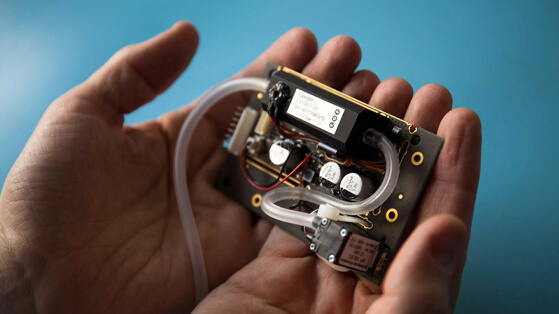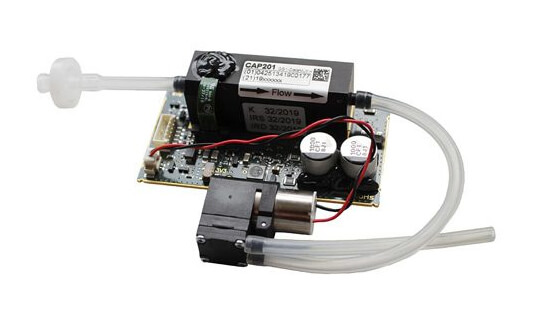Capnography for emergency care and clinical use

Measuring CO2 is part of our core expertise. See below for our specialist article on capnography for emergency care and clinical use.

Dr. Tobias Troeger – Head of Research & Development at Corscience GmbH & Co. KG
In order to monitor and assess the health status of ventilated patients, it is necessary to continuously analyse the tidal air using medical gas sensors. A typical measurement is the end-tidal carbon dioxide concentration (etCO2), which capnometry determines as the maximum value at the end of the exhalation phase. By using the etCO2 value, the CO2 partial pressure of the arterial blood (paCO2), which otherwise would have to be determined using blood gas analysis, and the patient’s respiration can be inferred. This also helps to check and monitor tube placement for patients with endotracheal intubation. Thus capnography, i.e. the graphically illustrated CO2 measurement curve, is today a widely used technique in emergency care and clinical applications such as in intensive care and anaesthesia. It represents the gold standard in many areas.
Thus capnography, i.e. the graphically illustrated CO2 measurement curve, is today a widely used technique in emergency care and clinical applications such as in intensive care and anaesthesia. It represents the gold standard in many areas.
Capnometry even plays an important role in the monitoring of patients who have not yet undergone artificial ventilation. For example, it can detect that a patient’s spontaneous respiration is inadequate and that intubation may be necessary. Moreover, as part of lung function tests and performance diagnostics, the functional capability of the patient’s respiratory system and physical capacity can be assessed using capnography.
As an experienced and qualified provider of gas analysis sensors, with the CAP201, Corscience offers a sophisticated and reliable OEM module for capnography for emergency care and clinical use. The measurement principle is based on non-dispersive infrared spectroscopy, which uses the specific absorption properties of CO2 in the infrared spectrum. During the measurement, a broadband infrared emitter directs waves of light through a measuring volume of the respiratory gas. An infrared detector is used to record the measurement signal. An optical bandpass filter is positioned in front of this, and it is tuned to the relevant wave length. Due to the physical interaction with the CO2 molecules, the intensity of the infrared light is attenuated. Given the fact that the measurement signal decreases as the number of CO2 molecules in the measurement volume increases, the CO2 concentration can be calculated based on the Lambert-Beer law.
The CAP201 works in sidestream mode, in which a pump continuously sucks a small amount of the tidal air into a measuring chamber, i.e. the cuvette. Compared to mainstream modules that measure directly at the breathing tube and increase its weight, no additional forces act on the tube of an intubated patient and the extubation risk remains low. In addition, sidestream modules are exposed to less contamination and can be more easily used to monitor non-intubated patients.
When developing the CAP201 capnography module, requirements for emergency care (IEC 60601-1-12, EN 1789) and for clinical applications were given particular consideration. The module is characterised by a high level of reliability and it is intended for robust use thanks to its compact and stable design. Moreover, it offers substantially higher accuracy than the standard for respiratory gas monitors requires (ISO 80601-2-55). By measuring the reference using an additional channel, the CAP201 compensates for aging effects and ensures compliance with the measuring accuracy during its entire life cycle. It therefore does not have to be calibrated in the field.
The measurement range of the CAP201 covers a CO2 concentration of 0 to 16 volume percent, whereby the CO2 values can alternatively be output as partial pressure in millimetres of mercury (mmHg) or kPa. Depending on the application, two data rates 8 Hz and 40 Hz. The measurement accuracy is +/-0.26 volume percent +/-5% of the measured CO2 value for a measurement resolution of 0.1 volume percent. The rise time T10-90, i.e. the minimum duration of a rise from 10% to 90% of the signal level is less than 100 ms at a volume flow of 80 ml/min.
Particularly in the field of emergency care, capnography modules must work reliably in adverse environmental conditions. The CAP201 can be used in an air-pressure range of between 540 hPa and 1200 hPa making it suitable both for high altitudes and for areas considerably below sea level. In addition, it is possible to carry out measurements in a temperature range of -10°C to 65°C at a relative humidity of up to 95%. The CAP201 reliably corrects deviations in the measurement signal caused by variations in the air pressure or temperature, that are unavoidable given the measurement principle, by means of an integrated compensation procedure. A warm-up time of less than 5 seconds ensures that the module is immediately ready for use in emergency care.
The CAP201 is characterised by a low weight of 69 g (including the pump) with dimensions measuring 70 x 40 x 26 mm. The module can be operated with input voltages of between 3.3 V and 7.2 V. The average power consumption is approx. 1 Watt.
The CAP201 determines certain clinical parameters for analysis of the respiration curve. Aside from the etCO2 value, the concentration of the inhaled carbon dioxide (fiCO2) and the respiration rate in a range of 3 to 150 breaths per minute are also calculated. If a respiration curve is not available or a blockage is detected in the tube system, the CAP201 sends an alarm signal to the host system.
Some special medical applications place additional requirements on capnography modules. For example, a version of the CAP201 without ferromagnetic components is available to reliably monitor patients in MRI scanners with a field strength of up to 3 Tesla. Other customer-specific adaptations to the CAP201 are possible for a high-pressure setting, for greater accuracy in performance and lung function diagnostics or for use in mainstream measurements.

„Based on capnography, Corscience has many years of experience in the development, production and maintenance of spectroscopic gas sensors. Our profound technical know-how in medical gas analysis ranges from sidestream measurement in emergency ventilation to the mainstream measurement in intensive care. Specific application knowledge and customer-centered thinking complete our profile as a competent OEM partner and development service provider.“